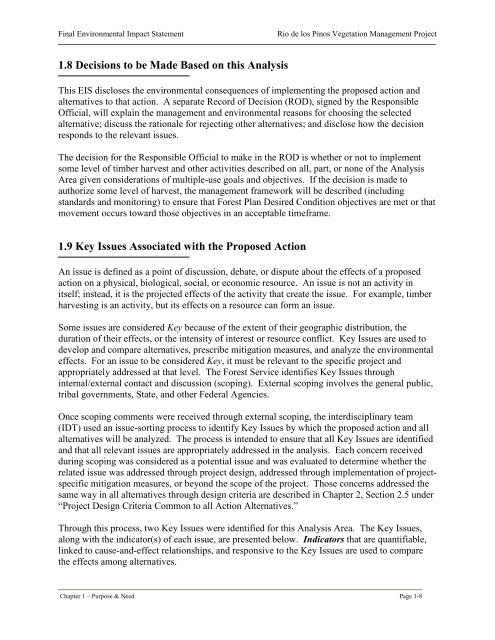Final Environmental Impact Statement Rio de los Pinos Vegetation ...
Final Environmental Impact Statement Rio de los Pinos Vegetation ...
Final Environmental Impact Statement Rio de los Pinos Vegetation ...
Create successful ePaper yourself
Turn your PDF publications into a flip-book with our unique Google optimized e-Paper software.
<strong>Final</strong> <strong>Environmental</strong> <strong>Impact</strong> <strong>Statement</strong> <strong>Rio</strong> <strong>de</strong> <strong>los</strong> <strong>Pinos</strong> <strong>Vegetation</strong> Management Project<br />
1.8 Decisions to be Ma<strong>de</strong> Based on this Analysis<br />
This EIS disc<strong>los</strong>es the environmental consequences of implementing the proposed action and<br />
alternatives to that action. A separate Record of Decision (ROD), signed by the Responsible<br />
Official, will explain the management and environmental reasons for choosing the selected<br />
alternative; discuss the rationale for rejecting other alternatives; and disc<strong>los</strong>e how the <strong>de</strong>cision<br />
responds to the relevant issues.<br />
The <strong>de</strong>cision for the Responsible Official to make in the ROD is whether or not to implement<br />
some level of timber harvest and other activities <strong>de</strong>scribed on all, part, or none of the Analysis<br />
Area given consi<strong>de</strong>rations of multiple-use goals and objectives. If the <strong>de</strong>cision is ma<strong>de</strong> to<br />
authorize some level of harvest, the management framework will be <strong>de</strong>scribed (including<br />
standards and monitoring) to ensure that Forest Plan Desired Condition objectives are met or that<br />
movement occurs toward those objectives in an acceptable timeframe.<br />
1.9 Key Issues Associated with the Proposed Action<br />
An issue is <strong>de</strong>fined as a point of discussion, <strong>de</strong>bate, or dispute about the effects of a proposed<br />
action on a physical, biological, social, or economic resource. An issue is not an activity in<br />
itself; instead, it is the projected effects of the activity that create the issue. For example, timber<br />
harvesting is an activity, but its effects on a resource can form an issue.<br />
Some issues are consi<strong>de</strong>red Key because of the extent of their geographic distribution, the<br />
duration of their effects, or the intensity of interest or resource conflict. Key Issues are used to<br />
<strong>de</strong>velop and compare alternatives, prescribe mitigation measures, and analyze the environmental<br />
effects. For an issue to be consi<strong>de</strong>red Key, it must be relevant to the specific project and<br />
appropriately addressed at that level. The Forest Service i<strong>de</strong>ntifies Key Issues through<br />
internal/external contact and discussion (scoping). External scoping involves the general public,<br />
tribal governments, State, and other Fe<strong>de</strong>ral Agencies.<br />
Once scoping comments were received through external scoping, the interdisciplinary team<br />
(IDT) used an issue-sorting process to i<strong>de</strong>ntify Key Issues by which the proposed action and all<br />
alternatives will be analyzed. The process is inten<strong>de</strong>d to ensure that all Key Issues are i<strong>de</strong>ntified<br />
and that all relevant issues are appropriately addressed in the analysis. Each concern received<br />
during scoping was consi<strong>de</strong>red as a potential issue and was evaluated to <strong>de</strong>termine whether the<br />
related issue was addressed through project <strong>de</strong>sign, addressed through implementation of projectspecific<br />
mitigation measures, or beyond the scope of the project. Those concerns addressed the<br />
same way in all alternatives through <strong>de</strong>sign criteria are <strong>de</strong>scribed in Chapter 2, Section 2.5 un<strong>de</strong>r<br />
“Project Design Criteria Common to all Action Alternatives.”<br />
Through this process, two Key Issues were i<strong>de</strong>ntified for this Analysis Area. The Key Issues,<br />
along with the indicator(s) of each issue, are presented below. Indicators that are quantifiable,<br />
linked to cause-and-effect relationships, and responsive to the Key Issues are used to compare<br />
the effects among alternatives.<br />
Chapter 1 – Purpose & Need Page 1-8
















